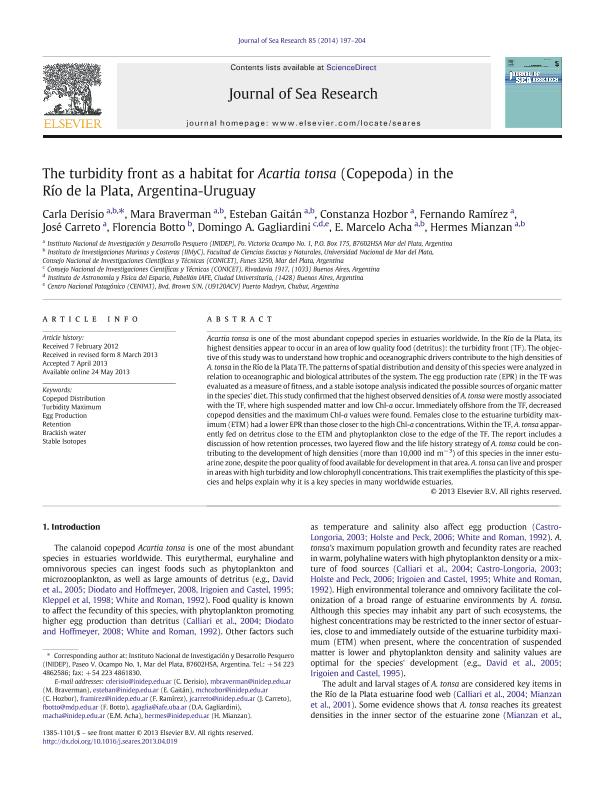Artículo
The turbidity front as a habitat for Acartia tonsa (Copepoda) in the Río de la Plata, Argentina-Uruguay
Derisio, Carla María ; Braverman, Mara Silvia
; Braverman, Mara Silvia ; Gaitán, Esteban Nicolás
; Gaitán, Esteban Nicolás ; Hozbor, Constanza; Ramírez, Fernando; Carreto Iraurgui, Jose Ignacio; Botto, Florencia
; Hozbor, Constanza; Ramírez, Fernando; Carreto Iraurgui, Jose Ignacio; Botto, Florencia ; Gagliardini, Domingo Antonio
; Gagliardini, Domingo Antonio ; Acha, Eduardo Marcelo
; Acha, Eduardo Marcelo ; Mianzan, Hermes Walter
; Mianzan, Hermes Walter
 ; Braverman, Mara Silvia
; Braverman, Mara Silvia ; Gaitán, Esteban Nicolás
; Gaitán, Esteban Nicolás ; Hozbor, Constanza; Ramírez, Fernando; Carreto Iraurgui, Jose Ignacio; Botto, Florencia
; Hozbor, Constanza; Ramírez, Fernando; Carreto Iraurgui, Jose Ignacio; Botto, Florencia ; Gagliardini, Domingo Antonio
; Gagliardini, Domingo Antonio ; Acha, Eduardo Marcelo
; Acha, Eduardo Marcelo ; Mianzan, Hermes Walter
; Mianzan, Hermes Walter
Fecha de publicación:
01/2014
Editorial:
Elsevier Science
Revista:
Journal of Sea Research
ISSN:
1385-1101
Idioma:
Inglés
Tipo de recurso:
Artículo publicado
Clasificación temática:
Resumen
Acartia tonsa is one of the most abundant copepod species in estuaries worldwide. In the Río de la Plata, its highest densities appear to occur in an area of low quality food (detritus): the turbidity front (TF). The objective of this study was to understand how trophic and oceanographic drivers contribute to the high densities of A. tonsa in the Río de la Plata TF. The patterns of spatial distribution and density of this species were analyzed in relation to oceanographic and biological attributes of the system. The egg production rate (EPR) in the TF was evaluated as a measure of fitness, and a stable isotope analysis indicated the possible sources of organic matter in the species' diet. This study confirmed that the highest observed densities of A. tonsa were mostly associated with the TF, where high suspended matter and low Chl-a occur. Immediately offshore from the TF, decreased copepod densities and the maximum Chl-a values were found. Females close to the estuarine turbidity maximum (ETM) had a lower EPR than those closer to the high Chl-a concentrations. Within the TF, A. tonsa apparently fed on detritus close to the ETM and phytoplankton close to the edge of the TF. The report includes a discussion of how retention processes, two layered flow and the life history strategy of A. tonsa could be contributing to the development of high densities (more than 10,000 ind m−3 ) of this species in the inner estuarine zone, despite the poor quality of food available for development in that area. A. tonsa can live and prosper in areas with high turbidity and low chlorophyll concentrations. This trait exemplifies the plasticity of this species and helps explain why it is a key species in many worldwide estuaries.
Archivos asociados
Licencia
Identificadores
Colecciones
Articulos(CCT - MAR DEL PLATA)
Articulos de CTRO.CIENTIFICO TECNOL.CONICET - MAR DEL PLATA
Articulos de CTRO.CIENTIFICO TECNOL.CONICET - MAR DEL PLATA
Articulos(IIMYC)
Articulos de INSTITUTO DE INVESTIGACIONES MARINAS Y COSTERAS
Articulos de INSTITUTO DE INVESTIGACIONES MARINAS Y COSTERAS
Citación
Derisio, Carla María; Braverman, Mara Silvia; Gaitán, Esteban Nicolás; Hozbor, Constanza; Ramírez, Fernando; et al.; The turbidity front as a habitat for Acartia tonsa (Copepoda) in the Río de la Plata, Argentina-Uruguay; Elsevier Science; Journal of Sea Research; 85; 1-2014; 197-204
Compartir
Altmétricas



